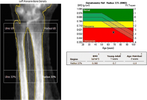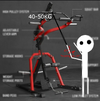- Joined
- Jun 21, 2024
- Messages
- 2,708
- Solutions
- 1
- Reputation
- 7,307
This thread marks a Wingspan-Catch-up method to those with disproportionate arms to their legs or if they just want longer arms.
This will focus on lengthening the two Forearm Bones
The principle/theory of Mechanotransduction must be understood to apply this correctly
Mechanotransduction is the process by which mechanical stimuli are converted into biochemical signals, leading to cellular responses, read my other thread for more information but this is the basis.
We will be providing cyclic/torsional stimuli placed more so to the bone rather than tensile.
This method has inspiration taken from Tennis players, who have discrepancies in bone length and density.
This method may require DEXA Scans for precise calculations, but estimates can suffice.
 Something like this
Something like this
Either a DEXA SCAN or use a Caliper
Everything is subject to change depending on YOU, this is not liable on me if you go on with this routine and get harmed.
Step-by-Step
1.Magnitude of Load
USE THIS CALCULATION : F=18×106×π×(2d)2
D being the diameter of your radius
2. Fluid Flow Enhancement
5. Final Routine

Monitoring and Adjustments
I know most people that would do this wont do the monitoring, just be safe with your progress, dont be too ambitious, get k2 and vit2 and calcium in your diet and only expect results over a long time. Not following with a safety protocol can cause more damage to you than good.
What I hope to achieve:
By using a lever system to apply the necessary force, we can make the exercise routine practical and safe, effectively leveraging mechanotransduction principles to stimulate bone growth and forearm lengthening.
Some other things:
Muscles,ligaments,tendons,etc may be too weak. A gym wrap around the grip or more friction in general could increase your ability to keep lengthening in 10 min sessions. You could do this routine, I found 40 min of considerable lengthening per session to be very promising or tennis may work. Tennis itself would require you to play with both hands and longer periods of time due to less constant forces of torsion.
This will focus on lengthening the two Forearm Bones
The principle/theory of Mechanotransduction must be understood to apply this correctly
Mechanotransduction is the process by which mechanical stimuli are converted into biochemical signals, leading to cellular responses, read my other thread for more information but this is the basis.
We will be providing cyclic/torsional stimuli placed more so to the bone rather than tensile.
This method has inspiration taken from Tennis players, who have discrepancies in bone length and density.
This method may require DEXA Scans for precise calculations, but estimates can suffice.
 Something like this
Something like thisEither a DEXA SCAN or use a Caliper
- Vernier caliper, Digital one is better
- Locate the area of your forearm where you want to measure the radius.
Place the caliper jaws around the bone perpendicular to its length.
Gently close the jaws until they touch the bone, ensuring the caliper is secure.
Note down the measurement displayed on the caliper. Digital calipers usually display measurements in millimeters (mm). - For an adult, the diameter of the radius can range from approximately 8 -12 mm on average.
Everything is subject to change depending on YOU, this is not liable on me if you go on with this routine and get harmed.
Step-by-Step
1.Magnitude of Load
- Microstrain Calculation:
- Aiming for the range of 1000-1500 με, this aims for 0.01%-0.015% change in original length
- For a typical forearm bone (radius), the following assumptions need to be made without a DEXA Scan:
- Young’s modulus (E) of cortical bone: ~18 GPa (18,000 MPa)
Strain (ε) = Stress (σ) / Young’s modulus (E)
USE THIS CALCULATION : F=18×106×π×(2d)2
D being the diameter of your radius
- Cross-sectional area (A) of the forearm bone can be approximated.
- For simplicity, assume the radius has a diameter of 1.5 cm.( EVERYTHING BELOW RELIES ON THIS DIAMETER)
- Using the calculation above this radius with a d of 1.5cm needs approx 3,186 N of force to generate 1000 Microstrain units( RAW FORCE OF 326 kg relation to 1.5cm diameter of radius)
- This weight (326 kg) is not practical for direct use in exercise. Instead, we can apply the force through mechanical means or use a lever system to achieve the same effect with a more manageable weight.
- Using a mechanical advantage of 10: Required weight = 326 kg
- 326 kg/2 = 32.6 kg
- 32.6kg is not enough for both bones and all of the other soft tissue surrounding, Specific percentages can vary, but estimates suggest that soft tissues can absorb anywhere from 20% to 50% of the applied mechanical forces, depending on the activity and loading conditions.
- Add another 20-50% of kg depending on how it feels(test it out especially if you dont have a dexa scan)
- Around 40-50KG may suffice.
2. Fluid Flow Enhancement
- Cyclic Loading:
- Cyclic loading helps stimulate bone remodeling and fluid flow.
- Use a frequency of 1 Hz (one cycle per second) for optimal fluid flow and mechanotransductive response.
- Apply the load cyclically to achieve dynamic loading conditions.
- Torsional Loading Parameters:
Frequency: 1-2 Hz (one to two twists per second)
Angle of Rotation: 5-15 degrees of rotation(Mimicking tennis strikes)
- Repetition Parameters:
- 10 minutes per session.
- Perform the exercise 4 times a day, allowing rest and recovery.
5. Final Routine

- Warm-Up:
- 5 minutes of light exercise to increase blood flow.
- Loading Exercise:
- Equipment: Lever system with a mechanical advantage of 10.
- Weight: e.g. 40-50kg
- Application: Secure the forearm in a position where the lever applies the force evenly along the forearm bone.
- Cyclic Loading: Apply the load at 1-2 Hz frequency (one to two cycles per second) for 10 minutes.
- Cool Down:
5 minutes of light stretching and relaxation exercises.
Repetition:
Repeat the entire routine 4 times a day.
Ensure at least 4 hours between sessions to allow bone recovery and adaptation.
Monitoring and Adjustments
- Regular Assessments: Bi-weekly imaging (e.g., X-rays) to monitor bone growth and alignment.
- Adjust Load: If necessary, adjust the load based on the progress and feedback from medical professionals.
- Progressive Overload: Gradually increase the load by 5-10% every 2 weeks, ensuring it remains within safe limits.
I know most people that would do this wont do the monitoring, just be safe with your progress, dont be too ambitious, get k2 and vit2 and calcium in your diet and only expect results over a long time. Not following with a safety protocol can cause more damage to you than good.
What I hope to achieve:
By using a lever system to apply the necessary force, we can make the exercise routine practical and safe, effectively leveraging mechanotransduction principles to stimulate bone growth and forearm lengthening.
Some other things:
Muscles,ligaments,tendons,etc may be too weak. A gym wrap around the grip or more friction in general could increase your ability to keep lengthening in 10 min sessions. You could do this routine, I found 40 min of considerable lengthening per session to be very promising or tennis may work. Tennis itself would require you to play with both hands and longer periods of time due to less constant forces of torsion.


